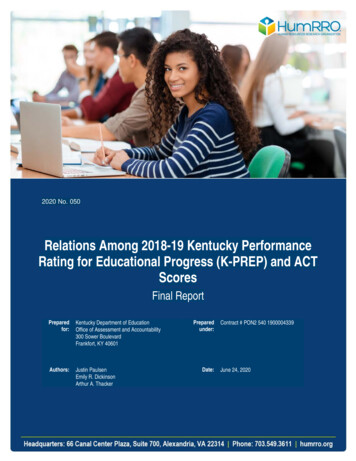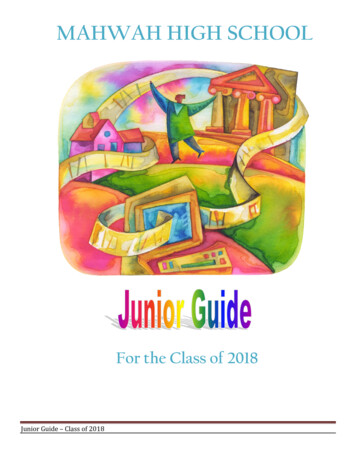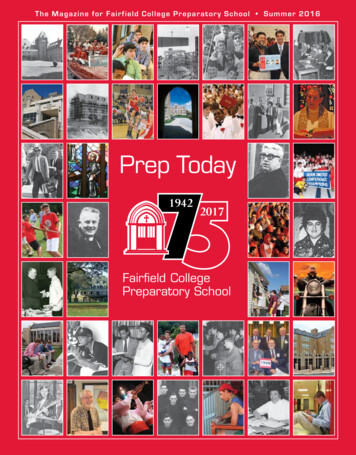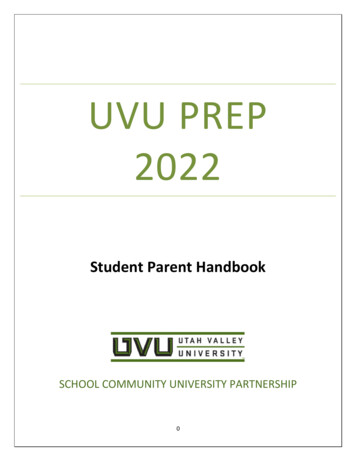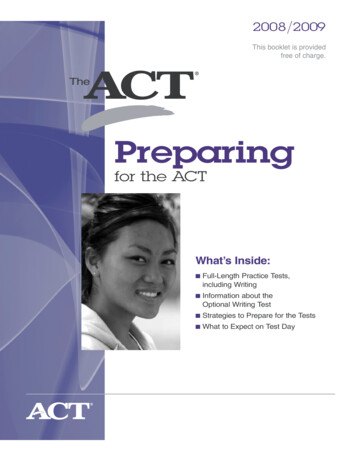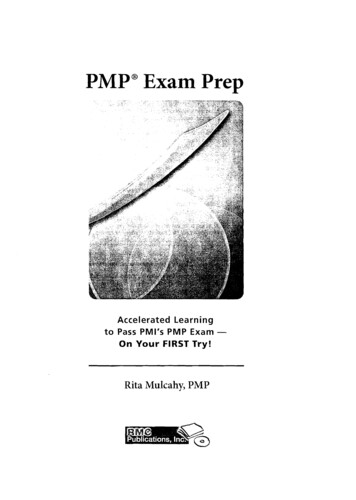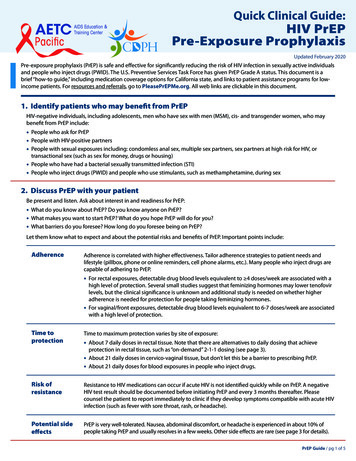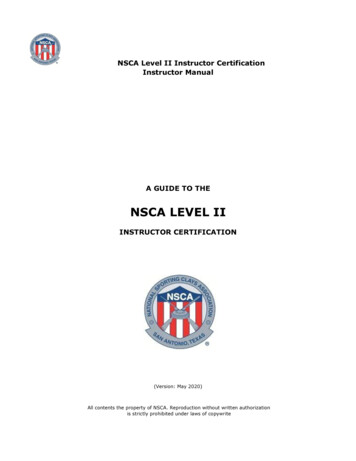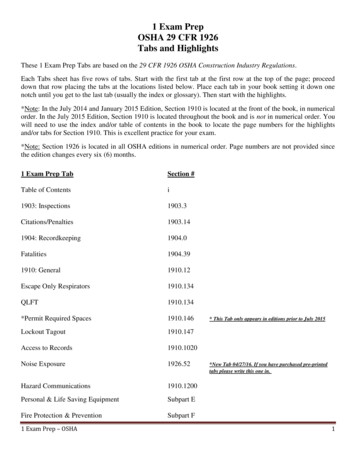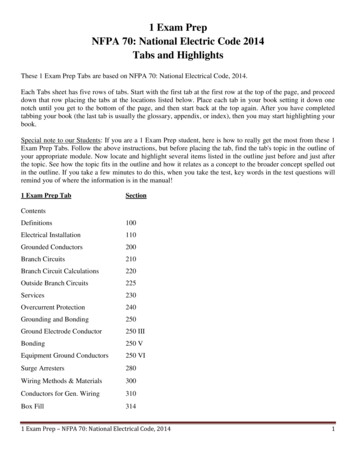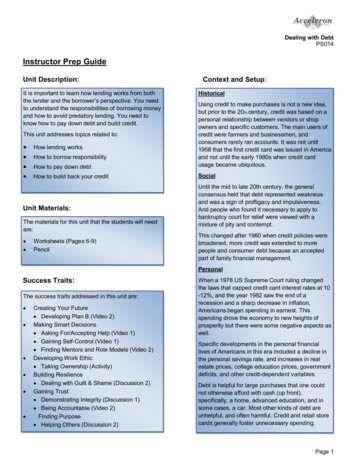
Transcription
Dealing with DebtPS014Instructor Prep GuideUnit Description:It is important to learn how lending works from boththe lender and the borrower’s perspective. You needto understand the responsibilities of borrowing moneyand how to avoid predatory lending. You need toknow how to pay down debt and build credit.How to pay down debtHow to build back your creditSocialHow lending worksHow to borrow responsibilityUnit Materials:The materials for this unit that the students will needare: HistoricalUsing credit to make purchases is not a new idea,but prior to the 20th century, credit was based on apersonal relationship between vendors or shopowners and specific customers. The main users ofcredit were farmers and businessmen, andconsumers rarely ran accounts. It was not until1958 that the first credit card was issued in Americaand not until the early 1980s when credit cardusage became ubiquitous.This unit addresses topics related to: Context and Setup:Worksheets (Pages 6-9)PencilUntil the mid to late 20th century, the generalconsensus held that debt represented weaknessand was a sign of profligacy and impulsiveness.And people who found it necessary to apply tobankruptcy court for relief were viewed with amixture of pity and contempt.This changed after 1980 when credit policies werebroadened, more credit was extended to morepeople and consumer debt because an acceptedpart of family financial management.PersonalSuccess Traits:The success traits addressed in this unit are: Creating Your Future Developing Plan B (Video 2)Making Smart Decisions Asking For/Accepting Help (Video 1) Gaining Self-Control (Video 1) Finding Mentors and Role Models (Video 2)Developing Work Ethic Taking Ownership (Activity)Building Resilience Dealing with Guilt & Shame (Discussion 2)Gaining Trust Demonstrating Integrity (Discussion 1) Being Accountable (Video 2)Finding Purpose Helping Others (Discussion 2)When a 1978 US Supreme Court ruling changedthe laws that capped credit card interest rates at 10-12%, and the year 1982 saw the end of arecession and a sharp decrease in inflation,Americans began spending in earnest. Thisspending drove the economy to new heights ofprosperity but there were some negative aspects aswell.Specific developments in the personal financiallives of Americans in this era included a decline inthe personal savings rate, and increases in realestate prices, college education prices, governmentdeficits, and other credit-dependent variables.Debt is helpful for large purchases that one couldnot otherwise afford with cash (up front),specifically, a home, advanced education, and insome cases, a car. Most other kinds of debt areunhelpful, and often harmful. Credit and retail storecards generally foster unnecessary spending.Page 1
Dealing with DebtPS014The Lesson PresentationIntroduction to the LessonToday we are going to learn the importance of dealing with debt. It is important to learn how lending works from boththe lender and the borrower’s perspective. You need to understand the responsibilities of borrowing money and how toavoid predatory lending (payday loans, title loans, etc.). You need to know how to pay down debt and build credit.This unit addresses topics related to: How lending worksHow to borrow responsibilityHow to pay down debtHow to build back your creditThe format of our class today will be: Watch Video 1 Discuss our thoughts and reactions to video 1 Watch Video 2 Do an activity Discuss our thoughts and reactions Take a quiz over the material presented Post-release cheat sheet (a handout for future reference)Show Video Part 1Discussion Questions 12. What are some reasons that you need to work todevelop a good credit score?1. What are some things that you might use long termloans for? Why might you use short term loans?Which type of debt (short or long term) is generallybest and why?Potential responses to question 1: (responses will vary) Buying a house long term Buying a car long term Shopping for Christmas short term Paying for education long term Buying furniture short term Long term is best, as it pays for things you probablycould not “save up for.” Avoid short term debt. Itoften has high interest and is for things you don’tneed or things that have no long-term value.Potential responses to question 2: (responses willvary) You can get a loan if you need it You can get a home loan You can get a lower interest rate It is easier to get a car loan A better credit score will reduce the interest ratethat you pay, lowering your cost of borrowingPage 2
Dealing with DebtPS0143. What are some things that provide collateral(secured loans) when you borrow? What are somethings that do not (unsecured)?4. What are some of the reasons that it is importantthat you pay on your loans in a timely manner?*(Demonstrating Integrity)Potential responses to question 3: (answers may vary)Potential responses to question 4: (answers may vary) Car note secured It is the right thing to do Credit card unsecured You can be sued if you do not House loan secured They can take back or seize the collateral Student loan unsecured (unless co-signed bysomeone with assets) It will help to build your credit score Furniture loan secured JC Penny’s credit card unsecuredYou may eventually want another loan and youare more likely to get one if you have paid backthe money that you have already borrowed or arepaying it back correctly Best Buy credit card unsecured5. What are some things that you need to know whenyou go to apply for a loan?Potential responses to question 5: (answers may vary) You are legally required to pay it back. Do notborrow more than you ABSOLUTELY need You will need to prove that you can pay it back You have to have a social security or tax IDnumber You have to prove where you live You will need to show that you have bankaccountsShow Video Part 2Page 3
Dealing with DebtPS014ActivityDescription of the activity:The students will use the information provided in Worksheet A (Inventory Debt page 6) to populate andcreate a debt repayment plan on Worksheet C (Repayment Plan page 8). *(Taking Ownership)Page 7 is a detailed explanation of how to use the Snowball repayment plan/approach.Additionally, we have provided a second version of Worksheet A(Inventory Debt page 9) that is not pre-populated with financialinformation. This is for students to input their personal debt informationif they know what they currently owe, or for them to use as a templateupon release.Concluding Discussion1. What are some ways to determine if your lender isa predatory lender?2. What are some things that you need to addresswhen you are looking at developing a debt paymentplan? *(Dealing with Shame and Guilt)Potential responses to question 1: (responses willvary)Potential responses to question 2: (responses willvary) High fees and interest You have to be honest about what debt you have Extra fees and add-ons that cost money You have to prioritize your debt Penalties if you pay off the loan early. You shouldbe able to pay off the loan early. The loan offers balloon payments. This happenswhen you have lower monthly amounts but a largepayment at the end. If you cannot make the largepayment, it is viewed as the loan not being paid.After you have separated out your secured debt,you need to find the smallest amount you owe onyour unsecured debt and pay it off first You cannot gain more debt as you are paying it off How you actually got into debt and how you willavoid it in the future Admitting all of the debt that you have to a trustedfamily member or friend, and having them holdyou accountable to pay it back on a schedule They have a bait & switch policy. This means thatthey can change the deal as they go and it willalways benefit them.Page 4
Dealing with DebtPS0143. What are some concepts you need to remember ifyou are being a responsible borrower?4. What was something you found difficult orconcerning about the activity? What did you findeasy?Potential responses to question 3: (responses willvary)Potential responses to question 4: (responses willvary) You have to pay back all of the money that youborrow I didn’t understand how the bank calculates howmuch I owe them each month Borrow the least amount you need only borrowenough to buy what you need to buy, don’t getextra. It looked like it would take a long time to pay offthe debts It didn’t look like I owed that much until I put it alltogether like this Understand what the paperwork says Crate a repayment plan for yourself and makesure you keep to it I liked the Snowball method for paying off mydebts Add your monthly payment into your budget. Onlyborrow what you can AFFORD to pay back. It was good to see that there was a way out ofdebt and that I can take steps on my own5. How do you feel that the snowball payment methodworks for paying off debt? Is there a way that you likebetter? Why?6. How can you help others using the information youlearned today? *(Helping Others)Potential responses to question 5: (responses willvary)Potential responses to question 6: (responses willvary) I didn’t like using the snowball method. I think thatthe envelope method would work better for me. Discuss with someone how to build a repaymentplan I liked that I could see a way to pay off my debtand it would really work Talk about how to lending works It will be hard not to spend that money otherplaces after I pay off one debtShare information about how to pay down yourdebts (snowball method) Teach someone how to be a responsible borrower It was good to practice it and see how it reallyworkdsQuizPage 5
Name:Dealing with DebtPS014Activity WorksheetWorksheet A Inventory Debt (Pre-populated version - alternate blank version on Page 9).Directions: Use the information provided below to calculate the total debt and total payments.Review the steps for the Snowball method (Page 7), then use the information below to create a debtrepayment plan (Page 8).DescriptionName ofLender orCreditorTotal Loan orDebt BalanceDueMinimumMonthlyPaymentExpectedPayoff Dateat CurrentRate ofRepaymentBank ofAmerica 738.87 252024NoJP Morgan 1,276.45 35.002019No2. Visa Acct. 7685Chase Bank 976.12 28.002021No3. Car NoteFord MotorCredit 7,892.12 256.342023NoIRS 567.09 67.342017NoVinnie Santos 1, 400.00 100.002017NoExamples: Credit cards, studentloans, personal loans, car loans,home mortgage, medical bills, backtaxes , restitution etc.Example: Visa Card Acct. 54431. Master Card Acct. 24354. Back Taxes5. Personal LoanIs It nts:Debt can turn a free, happy person into a bitter humanbeing. - Michael MihalikPage 6
Name:Dealing with DebtPS014Activity WorksheetWorksheet B Snowball ExampleDirections: Review the Snowball Method below and accompanying example, then complete therepayment plan on page 8.The SNOWBALL Method & Example1. List your debts from SMALLEST (total outstanding balance) to largest.2. Be sure you are always making at least the minimum payment on eachoutstanding debt.3. Apply any remaining funds towards paying off the smallest debt (totaloutstanding balance) as quickly as possible.4. Once the smallest debt is repaid, take the money you were using to repayit, plus any available funds and pay off the next smallest debt*5. Repeat this process. As money is freed up by each debt repayment, the amount available for thenext debt on the list will grow (or “snowball!”) until you are debt free.DescriptionTotal Debt BalanceRequired Minimum MonthlyPayment Amount(SMALLEST to Largest)1. Creditor #1 45.00 338.872. Creditor #2 25.00 459.393. Creditor #3 79.00 4,000.00A. Total monthly amount of money you can allocate to all debt repayments(this is all available money after basic living expenses are covered)B. Total of required minimum monthly paymentsC. Now calculate A - B. This is the amount that can be added to paying offCreditor #1, which is your TOP priority. Once paid off, you will recalculateA—B and include the money you WERE using for Creditor #1 and apply allavailable funds to Creditor #2 and so on. 200.00 (for example) 149.00 (add payments above) 51.00 (A - B)D. Total payment to Creditor #1 until Creditor #1 is paid off 45 51 96.00 (Minimum payment C)E. Total payment to Creditor #2 after Creditor #1 is paid off 25 96 121.00 (Minimum Payment D)F. Total payment to Creditor #3 after Creditor #2 is paid off 121 79 200.00 (Minimum Payment E)One exception: If you have debt that is in collections, back taxes or court-orderedrestitution, you should prioritize those items ahead of other kinds of debt.Page 7
Name:Dealing with DebtPS014Activity WorksheetWorksheet C Your Snowball Repayment PlanDirections: After reviewing the example on the prior page, complete the worksheet below using yourown debt information. Start with the smallest total DEBT that you owe (NOT the smallest monthly payment)and work up to the largest.DescriptionRequired Minimum MonthlyPayment AmountTotal Debt Balance(SMALLEST to Largest)1.2.3.4.5.A. Total monthly amount of money you can allocate to all debt repayments(this is all available money after basic living expenses are covered)B. Total of required minimum monthly paymentsC. Calculate A—BD. Total payment to Creditor #1 until Creditor #1 is paid offE. Total payment to Creditor #2 after Creditor #1 is paid offF. Total payment to Creditor #3 after Creditor #2 is paid offG. Total payment to Creditor #4 after Creditor #3 is paid offH. Total payment to Creditor #5 after Creditor #4 is paid offNote: Copy this page and continue with additional debts if you have more than 5 items.*One exception: If you have debt that is in collections, back taxes or court-orderedrestitution, you should prioritize those items ahead of other kinds of debt.Debt is like any other trap, easy enough to get into, buthard enough to get out of. — Henry Wheeler ShawPage 8
Name:Dealing with DebtPS014Activity WorksheetWorksheet A Inventory Debt (Blank or template version).Directions: List every amount that you owe, both the total amount remaining and each minimum orexpected monthly payment. If you are not sure of the exact amount, enter an estimated amount; you canenter actual amounts when better information is available.DescriptionExamples: Credit cards, studentloans, personal loans, car loans,home mortgage, medical bills, backtaxes , restitution etc.Example: Visa Card Acct. 5443Name ofLender orCreditorTotal Loan orDebt BalanceDueMinimumMonthlyPaymentExpectedPayoff Dateat CurrentRate ofRepaymentBank ofAmerica 738.87 252024Is It t:TotalPayments:Debt can turn a free, happy person into a bitter humanbeing. - Michael MihalikPage 9
Post-Release Cheat Sheet: Dealing with DebtThe Essentials Borrowing is the act of using someone else’s money. Interest is the cost of using someone else’s money. YouHAVE to pay back borrowed money with interest, it is not free.Predatory lending happens when you are charged excessive amounts of interest or extra fees, so read everything before borrowing or signing paperwork. Avoid payday, pawn, title loan, and rent-to-own shops.Responsible borrowing means knowing how much debt you can manage (does your budget allow you to makeat least the monthly payments, but preferably much more?) and refusing to take on debt beyond that.Paying down your debts should be a high priority and is one step you can take towards rebuilding your life.When you don’t owe money to other people, you have more options and greater flexibility.Frequently Asked Questions Q. How much do I really owe?A. Start by gathering all of the information. Most of it should come in periodic paper statements, or isavailable online. Create a consolidated list of debts that includes name of the lender, total balance remaining, minimum monthly payment, and expected payoff date. Q. Do I really have to pay it all back?A. Unfortunately, yes. Occasionally, creditors will agree to accept a lower amount due to hardship, and inRARE cases, the debt may have expired due to a statute of limitations. However, those are not the norm.Upon Release Make contact with your creditors first, before they call you (they will treat you better if you do). Find out howmuch you owe and discuss repayment options based on your available monthly income.Find work, and once you do, be a responsible employee. A steady job is one of the most important predictorsof whether or not you will stay out of prison.Create a monthly budget and live within your means. Be sure that your expenses include at least the minimum monthly repayments on all of your debts.Develop a debt repayment plan using the Snowball Method. The Snowball Method involves making minimumpayments on all of your debt. You prioritize the total amount due from smallest to largest, then focusing onpaying the smallest off first. Take the amount you were paying on the smallest debt and pay it on the nextsmallest, continuing until all your debts are paid off.Getting Assistance Get a full list of current and past debt from ALL THREE credit reporting agencies: equifax.com, experian.com andtransunion.com. Free credit scores and reports are available once per year from creditkarma.comPage 10
loans, personal loans, car loans, home mortgage, medical bills, back taxes , restitution etc. Name of Lender or reditor Total Loan or Debt alance Due Expected Payoff Date at urrent Rate of Repayment Is It In ollections? Minimum Monthly Payment Example: Visa ard Acct. 5443 ank of America 738.87 25 2024 No
